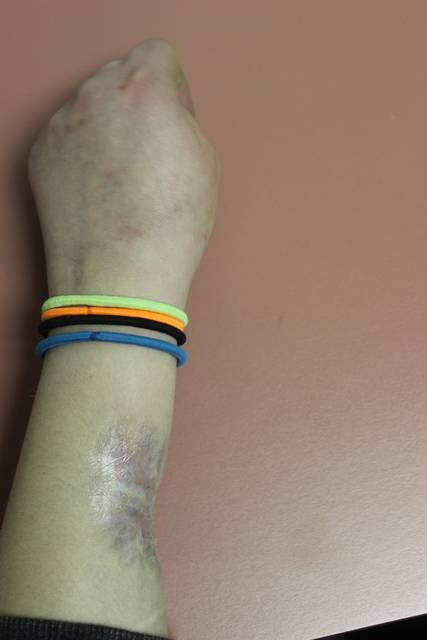



Narcotic opioids heroin, fentanyl and carfentanil were responsible for more than 64,000 drug overdose deaths in 2016 and the drug crisis continues to grow across the country. In Ohio people are dying from accidental opioid overdose deaths more often than from car accidents, with an estimated 14 dying each day. As the rate of drug use increases in rural Ohio, the number of life-threatening MRSA (Methicillin-resistant Staphylococcus aureus) and chronic hepatitis C infections are on the rise among people who use shared needles.
Stephanie Ottesen arrived at the Clinton County Memorial Hospital emergency department overwhelmed with pain in 2015.
“I thought, because I had been using a little bit of meth, but I was mostly a heroin addict, I had been staying up for days and I thought it was related to that meth and I just needed sleep. But then I had to take my jacket off at the hospital and the nurses saw my arm and I had open sores on my arm,” said Ottesen.
The open sores, near her wrist, remained covered most of the time. Ottesen said she was trying to hide the infection and described how it was caused by using shared syringes when she injected heroin or methamphetamine with her friends in her hometown of Blanchester.
“They knew right away that it was MRSA and rushed me in for treatment,” said Ottesen.
She spent hours in the emergency department. She learned that the multi-drug resistant MRSA had spread into the valves around her heart. Ottesen was placed into a Warren County nursing home for three months and said she was treated with a strong antibiotic, vancomycin, to kill the MRSA bacteria. Ottesen said she thought she was going to die from the MRSA infection but over time the antibiotic healed her heart.
She will always be a carrier for MRSA and will have to cope with having permanent skin abscesses and high blood pressure. Losing a piece of the skin on her arm from MRSA was traumatic, she said, and it wasn’t the last time she would rush to the emergency department to be seen for overwhelming pain.
Additional tests during her stay at the nursing home confirmed the MRSA infection was co-morbid with the hepatitis C virus, Ottesen said. Hepatitis C is transmitted primarily through contact with blood and using shared needles when injecting drugs. Recent research has shown that the hepatitis C virus can also survive outside of the body on surfaces for three weeks, with some research reportedly showing that it can remain active for six weeks. Hepatitis C infections increased 1,000 percent nationally in the period between 2011-15, the Centers for Disease Control and Prevention (CDC) reports, and the CDC attributed the growth to the opioid crisis in counties across the country.
“I was having pain in my back near my liver. I couldn’t walk. I went back to the hospital and the hospital did a CAT scan — they called me back saying there was a spot on my liver,” said Ottesen.
Ottesen said she was surprised by how suddenly the permanent damage set in once she had become infected with the pathogens. Left untreated, hepatitis C becomes a chronic disease that can possibly cause liver cancer or the kidneys to shut down.
Today she is on a waiting list for hepatitis C treatment and doesn’t yet know what her specific treatment plan will look like. Generally, the treatment for a chronic hepatitis C infection costs tens of thousands of dollars. One treatment cycle can cost a minimum of $65,000. A treatment cycle varies depending on the nature of the infection, but a single treatment can be a two, three, or four month program, or longer, depending on which medication is used and if a combination of medications are required to cleanse the body of the virus.
“I’m in the process of treatment for hep,” said Ottesen. “They have a recommendation for a liver doctor at the University of Cincinnati who told me I have to be clean six months to start the treatment. There’s a long waiting list to get to visit a liver doctor. I’m always hearing people talking about how they need to find a good liver doctor. For treatment I heard you take a pill every day for four months. Hepatitis is curable. In the past you’d have to get an injection every day in your stomach.”
In rural Clinton and Fayette counties, the rates of hepatitis C infections reported to the Ohio Department of Health nearly doubled in a two-year period. The CDC says the reported number of hepatitis C cases does not reflect the number of new infections annually, and estimates that as many as 34,000 new cases of hepatitis C go unreported each year.
Ottesen said that like other small towns in Ohio, the opioid crisis is obvious in Blanchester. At 27, she can name four people who have died here, including her best friend and her boyfriend. During high school and after graduation, Ottesen said she and her friends used methamphetamine and it was widely available in the community.
“Then the meth dried up,” said Ottesen. “I’d hold onto 20 dollars for a while but couldn’t find anyone who had any meth. Suddenly everyone had heroin. Eventually I tried it.”
In 2013, she began driving each day to Dayton — a two-hour round trip — to purchase heroin. She wasn’t alone. Ottesen said dozens of other people in the area were driving to Dayton to pick up drugs.
Across town, a 26-year-old woman recalled what it was like making daily trips as an 18-year-old to purchase heroin in Dayton.
“When you’re from Blanchester, Dayton is Shangri-La for a junkie. It’s the dope candy mountains of Ohio,” the 26-year-old said, who asked not to be named in this report.
Ottesen said herself and other methamphetamine users had already begun to inject methamphetamine when heroin was initially introduced to her in 2011 from Dayton.
“At that time no one ever overdosed. Heroin wasn’t that strong, it didn’t have all that stuff that is mixed in now. When the new stuff came out on the market, carfentanil, you were too afraid to use. I was still using,” said Ottesen.
Forty miles away, 28-year-old Sarah Karber in Fayette County said she too was afraid to continue using heroin when it started showing up in 2016 laced with new synthetic compounds like fentanyl and carfentanil. Karber overdosed in Washington Court House in early 2017, her first time ever in the six years she had been using heroin, and was revived by paramedics. The Washington Court House Police Department charged Karber with inducing panic for the overdose, which kicked her into a treatment program through the court system.
When asked what she thought the Fayette County community could do to change the opioid crisis, Karber said, “I think they need to have a needle exchange program here. Some people, their needle has broken, and they’ll walk down the street until they find one and pick it up and use it. Or they’ll go and buy a used one off someone. I’ve associated at a drug house in the past and had someone ask if I had an extra needle or old one they can buy from me.”
Karber said she never had any extra needles to sell. “I only had the one.”
In Blanchester, the 26-year-old said, “There should be a needle exchange. People should use needles only one time ever but there’s no other option, you only have the one needle. You just clean it out or whatever.”
She said needles are hard to find, increasing the chances of someone sharing syringes.
Ottesen said the community in Clinton County also needs to have a syringe exchange.
“A needle exchange would really help. It seems like everybody is getting MRSA now. I’ve had cellulitis. They should have pamphlets with information about how to get help, to know what treatment places are close. They need to give out Narcan, too. They should do that to at least save people,” said Ottesen. “In Blanchester we need more access and information and on-the-spot treatment. The heroin is here, there’s been a bunch of overdoses here, they need to come here to give people treatment.”
All of those interviewed claimed they obtained clean needles either by stealing them from diabetics or buying them from the “dope boys” for $5 each (“dope boys” are the men who also sell the heroin).
That wasn’t always the case, said Ottesen. For a while, she said she was able to buy packs of clean needles in Blanchester for less than $5.
“CVS pharmacy used to sell needles in Blanchester. It was like $3.95 for a 10 pack. Now you can’t buy them at the pharmacy. You might get a needle from the dope boys. You don’t even know if they’re clean from the dope boys. I’ve seen them take used needles and make them look new again, and re-sell them for 5 dollars,” said Ottesen.
When people can’t find clean needles, Ottesen said people use bleach to clean their used syringes, as the CDC recommends. That could mean re-using the same needle 60 times or more. A needle can last a user approximately one week, or until they start rigging it — replacing parts of the needle to keep it functioning.
“They call the needles ‘weapons of mass destruction,’” said Ottesen. “It’s crazy what people will do to fix their needle. Some use sandpaper just because it would be so dull, to try to sharpen it up. I’ve seen people cut the top off, use ear wax on the plunger, super glue, and some people rub it on their jeans to sharpen it up.”
When asked how many people in Clinton County are active users who have been known to share needles, both Blanchester women agreed that several dozen people at least, or perhaps hundreds of people, have hepatitis C infections from sharing syringes in the community but remain untreated, and therefore, undocumented.
Hepatitis C data recently released from the Ohio Department of Health shows Clinton County saw an increase in hepatitis C infections, from 60 in 2014 to 109 in 2016. In Fayette County, the rate was similar, with an increase from 64 infections in 2014 to 100 in 2016.
The Ohio Department of Health, the agency responsible for preventing the spread of bloodborne pathogens like hepatitis C, allows county health departments to take the lead to initiate programs to prevent the spread of disease. Ohio health departments are allowed, through the establishment of a 2015 Ohio Revised Code law, to operate syringe exchanges to prevent and provide medical screenings for hepatitis C and HIV.
Currently, however, the rural health departments in Clinton or Fayette counties direct people outside of the communities in search of syringe exchanges and hepatitis C screenings. Drug users are not tested for hepatitis C when they go to jail in Clinton and Fayette counties, either.
“I don’t have hep,” said the 26-year-old in Blanchester. “But one time in jail, a girl asked me, ‘Oh, you don’t have hep?’ She was surprised because everybody has hepatitis C — all the friends I had while I was using (heroin), they all have hep, even if they haven’t been tested, they all know they have hep. Everybody in jail has hep.”
Ottesen added, “Everybody in Blanchester shares needles and they all have hep now.”
These rural communities in southern Ohio aren’t quite ready for localized syringe exchange programs to reduce and prevent the spread of hepatitis C, said Paint Valley Alcohol, Drug Addiction and Mental Health (ADAMH) Board Executive Director Penny Dehner.
“We all need to come together. I think that’s the only way that can be tackled, but as we come together the thing that will always come up is the public perception. Who wants to take the foot forward to say your agency is handing out needles to heroin users?” said Dehner. “We need to educate the public first about needle exchanges before we hand out needles: It’s a preventative measure, it’s not enabling. So, we’re not there yet.”
For residents in Clinton and Fayette counties, the nearest health department approved syringe exchange is in Greene County at SafeTrade, 600 Pierce Dr., in Fairborn, nearly an hour’s drive from either county.
SafeTrade Program Manager Jessica Warner said the syringe exchange opened in November and has five clients. Partial funding comes from the Greene County Department of Health general fund. The program offers services to people in any county, but Warner said that of the five current clients, none are from Clinton or Fayette. Warner added that the county health departments in those counties “have all the information” about SafeTrade, but residents in Blanchester said they had not heard any information about a syringe exchange. One person interviewed in Blanchester said the idea of a needle exchange “sounds like something that happens in Vancouver and not in Ohio.”
When asked at a Kettering, Ohio press conference with reporters March 2 why county health departments don’t have needle exchanges, U.S. Secretary of Health and Human Services Secretary Alex Azar said that it’s not a federal problem. States determine which programs to fund and manage.
The Ohio Department of Health said that it doesn’t tell individual counties which programs the agencies are responsible for funding, either. Each county board of health retains the right to determine which programs they have in their communities and how to spend funding from sources like Medicaid, according Ohio Department of Health Assistant Director of Communications Melanie Amato.
“Think of it as harm reduction,” said Dehner. “Hopefully it’s preventing, but the community will just provide huge push back that we’re enabling and often times they misinterpret harm reduction as enabling, and I think we have a job to better educate our community about that. I think the health professionals get it, the health departments get it, but the general population doesn’t understand what needle exchanges are for. We’re saving lives.”
But Ottesen said that while a syringe exchange would provide much-needed resources and information to the dozens of people who carry bloodborne pathogens in her community, she said that some people would be too afraid to go.
Ottesen said that one time she was pulled over in a traffic stop and had two needles in a bag in the car that she said were clean and had never been used. She was charged for the offense of being in possession of drug abuse instruments.
In Clinton County, the first offense of possessing a syringe is 90 days in jail, second offense is 180 days in jail, and the third offense is one year in jail, for a second-degree misdemeanor of drug abuse instruments.
“I know I got in trouble for clean needles, so what are they going to do with a needle exchange? I can imagine the cops sitting there waiting to arrest people,” said Ottesen.





